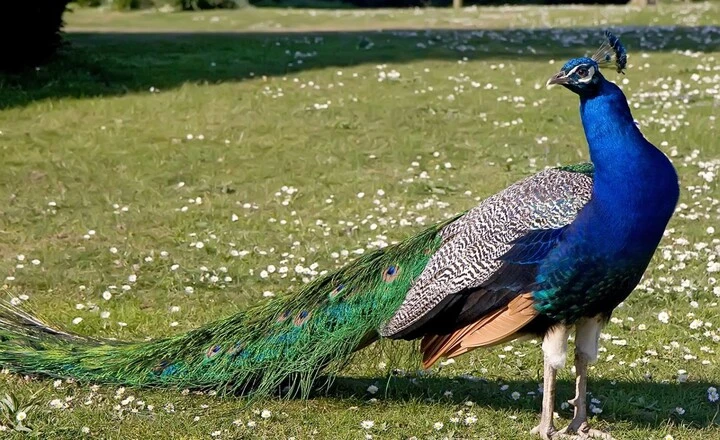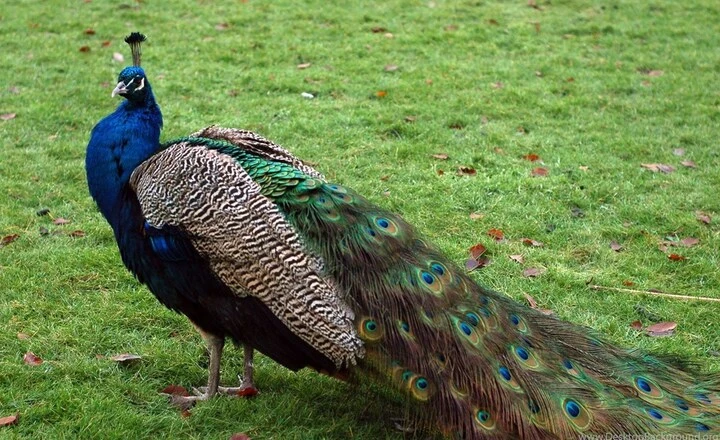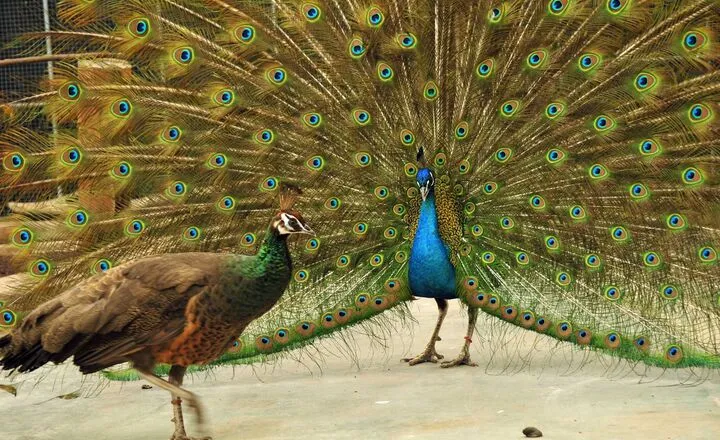Visualize walking through a lush garden surrounded by vibrant flowers and gentle leaves rustling. Out of the corner of your eye, you catch a glimpse of something truly mesmerizing a magnificent peacock proudly displaying its iridescent feathers in all their glory.
The sight is captivating, leaving you wondering Why Do Peacocks Spread Their Feathers? They have long been symbols of beauty and elegance, but there is more to their feathered spectacle than meets the eye.
Why Do Peacocks Spread Their Feathers (or Train)?
Peacocks spread their feathers, also known as a train, for a variety of reasons. One primary reason is to attract a mate during the mating season.
The vibrant and elaborate display of the peacock’s feathers is meant to catch the attention of female peafowls and signal his fitness as a potential partner.
Spreading their feathers can also serve as a way to intimidate potential predators by making themselves appear larger and more threatening.
Recent scientific studies have suggested that the size and coloration of a peacock’s tail feathers may indicate genetic quality and overall health.
This could explain why female peafowls often prefer peacocks with more extravagant and symmetrical trains during mating rituals.
The Peacocks Train
The intricate and vibrant display of feathers on a peacock’s train is truly a marvel of nature. These colorful feathers can weigh up to half a pound and make up a significant portion of the bird’s body length.
Scientists have found that the peacock’s train does not hinder its ability to fly or take off, debunking previous assumptions.

As peacocks age, their trains continue to grow longer and more elaborate with each passing year until they reach maturity at around six.
The stunning arrangement of colors and patterns on each feather, complete with an eyespot at the end, adds to the complexity of this beautiful display.
The Peacocks Ocellus
Female peahens are highly selective when choosing a mate, with the iridescent colors and change in color contrast of the peacock’s eye or ocellus playing a crucial role in their decision-making process.
Recent research has shown that it is not just the overall size or shape of the male’s train that matters, but rather the intensity and vibrancy of the blue-green eyespot along with the color contrast that determines breeding success.
Peacocks strategically angle their tail feathers at 45 degrees to the sun to showcase their brightest radiance to potential mates, ensuring that they display optimal iridescence for attracting female attention.
Scientists have discovered that this is only one aspect of why peahens choose one mate over another.
Comprehending these intricate dynamics can provide valuable insights into evolutionary processes and mate selection strategies among peafowl populations.
The Peacock Train Rattle
It is a fascinating behavior that plays a crucial role in the mating ritual of peafowl. Research indicates that the iridescent display of the peacock’s tail feathers is more about capturing the attention of a peahen rather than being a definitive commitment to mating.

Once a peahen is near, within half a meter, the peacock will start train-rattling by vibrating its tail feathers at a rapid rate of 25 times per second, creating sound waves that are picked up by the peahen through specialized crown feathers on her head.
These sound waves communicate between the potential mates, allowing the peahen to assess if the suitor is of the same species and physically fit enough to emit the right sounds to woo her.
This multi-sensory signaling process helps the peahen choose a mate based on both visual cues like iridescent colors and auditory signals such as the frequency and quality of the sound produced by the male.
The Peacock Train Rattle showcases how intricate and complex animal behaviors can be in the context of courtship and mate selection among peafowl.
Using Their Feathers for Intimidation
Peafowls, particularly peacocks, utilize their strikingly beautiful and elaborate feathers not only to attract mates but also as a means of defense against predators.
When faced with danger, these ground-feeding birds have limited options for protection and rely on the visual intimidation caused by fanning out their vibrant trains.
By making themselves appear larger than they actually are, peafowls can give potential predators pause and potentially deter an attack.
With lacking physical weapons or aggressive behavior, peafowls demonstrate ingenuity in using their feathers as a defense mechanism.
The intricate patterns and colors on their plumage create a visually imposing display that can startle or intimidate predators, giving the birds a chance to escape safely.
This adaptation showcases the evolutionary significance of the peacock’s train beyond its aesthetic appeal, highlighting how nature equips animals with unique strategies for survival in the wild.
How do Peafowl Communicate?
Peafowl, such as peacocks and peahens, communicate through various methods including sound waves and vibrations.
The elaborate train of a peacock emits sound waves that are picked up by the crown on the head of a peahen, serving as a form of communication during mating rituals.
Both male and female peafowl have vibration receptors on their crowns that can detect frequencies beyond human hearing, allowing them to communicate using these subtle cues.

Female peahens also use their tail feathers to create sound waves through vibrations. Scientists are studying how these birds use sound vibrations not only for mating purposes but also for group communication.
Research suggests that these vibrations can convey information about health, social status, and intentions among the birds, similar to how dogs use scent to communicate with each other.
More study is needed to fully understand the extent of communication in peafowl through multi-sensory signaling methods involving sounds made with their feathers.
The Downside of a Peacock’s Beauty
The downside of the male peacock’s stunning feathers extends beyond their aesthetic appeal. Poachers often target these birds for their feathers, which can fetch a high price on the global market.
This has led to a decline in wild peafowl populations, as males and females are captured for their plumage. The rise in popularity of keeping peafowl as pets among the wealthy has further exacerbated this issue, with poaching continuing to threaten these birds’ survival.
The imbalance in the ratio of male to female peafowl in captivity also poses challenges for the egg-laying peahens.
With multiple peahens typically kept for each male peacock, female competition can reduce breeding opportunities and genetic diversity.
The commercial value placed on these birds has fueled the demand for poaching, peacock prices ranging from $50 to $300 per bird in the USA. Addressing this issue will protect these majestic creatures from further exploitation and ensure their long-term conservation.
Conclusion
In above paragraphs we have discused this question Why Do Peacocks Spread Their Feathers? The extravagant display of peacock feathers serves multiple purposes in their natural environment. From attracting mates to establishing dominance and deterring predators, spreading feathers is essential to the peacock’s behavior.
Through centuries of evolution, these majestic birds have perfected the art of showcasing their vibrant plumage for survival and reproduction.
The significance behind this behavior sheds light on the intricate complexities of nature and the fascinating adaptations that have developed over time.
FAQs
What happens if we keep peacock feather?
In some Native American traditions, the peacock feather is seen as a symbol of integrity, beauty, and protection. It is believed to ward off negative energy and bring positive vibes into the space where it is kept.
What is the eye of a peacock feather called?
The eye of a peacock feather is called an ocellus, plural ocelli. These distinctive markings are created by pigmented cells that reflect light in a way that gives the illusion of an eye shape.
What does peacock symbolize?
The peacock is a symbol of beauty, grace, and elegance in many cultures worldwide. Its vibrant and iridescent feathers are often associated with qualities such as pride, confidence, and self-expression.
